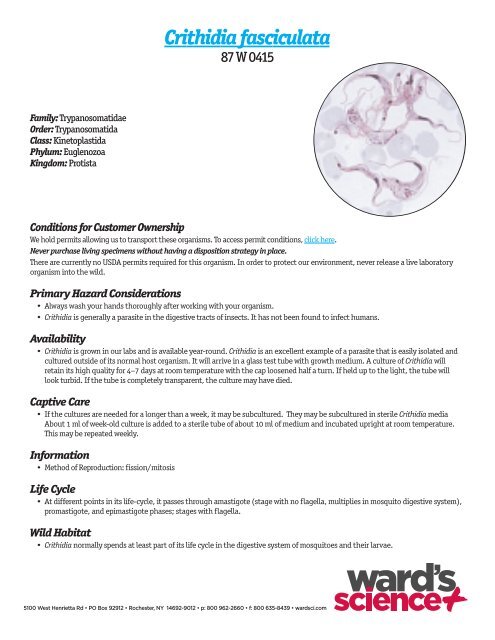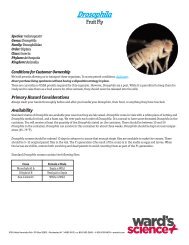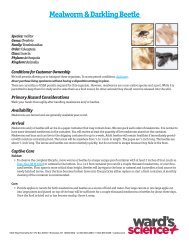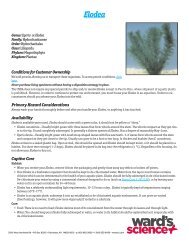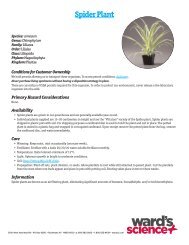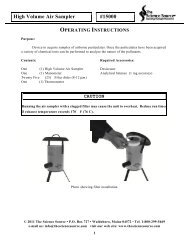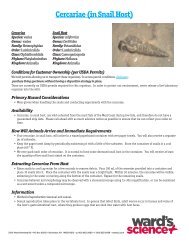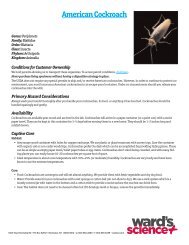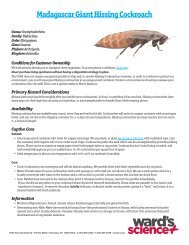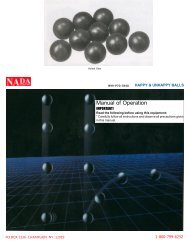Crithidia fasciculata - Sargent Welch
Crithidia fasciculata - Sargent Welch
Crithidia fasciculata - Sargent Welch
You also want an ePaper? Increase the reach of your titles
YUMPU automatically turns print PDFs into web optimized ePapers that Google loves.
<strong>Crithidia</strong> <strong>fasciculata</strong><br />
87 W 0415<br />
Family: Trypanosomatidae<br />
Order: Trypanosomatida<br />
Class: Kinetoplastida<br />
Phylum: Euglenozoa<br />
Kingdom: Protista<br />
Conditions for Customer Ownership<br />
We hold permits allowing us to transport these organisms. To access permit conditions, click here.<br />
Never purchase living specimens without having a disposition strategy in place.<br />
There are currently no USDA permits required for this organism. In order to protect our environment, never release a live laboratory<br />
organism into the wild.<br />
Primary Hazard Considerations<br />
• Always wash your hands thoroughly after working with your organism.<br />
• <strong>Crithidia</strong> is generally a parasite in the digestive tracts of insects. It has not been found to infect humans.<br />
Availability<br />
• <strong>Crithidia</strong> is grown in our labs and is available year-round. <strong>Crithidia</strong> is an excellent example of a parasite that is easily isolated and<br />
cultured outside of its normal host organism. It will arrive in a glass test tube with growth medium. A culture of <strong>Crithidia</strong> will<br />
retain its high quality for 4–7 days at room temperature with the cap loosened half a turn. If held up to the light, the tube will<br />
look turbid. If the tube is completely transparent, the culture may have died.<br />
Captive Care<br />
• If the cultures are needed for a longer than a week, it may be subcultured. They may be subcultured in sterile <strong>Crithidia</strong> media<br />
About 1 ml of week-old culture is added to a sterile tube of about 10 ml of medium and incubated upright at room temperature.<br />
This may be repeated weekly.<br />
Information<br />
• Method of Reproduction: fission/mitosis<br />
Life Cycle<br />
• At different points in its life-cycle, it passes through amastigote (stage with no flagella, multiplies in mosquito digestive system),<br />
promastigote, and epimastigote phases; stages with flagella.<br />
Wild Habitat<br />
• <strong>Crithidia</strong> normally spends at least part of its life cycle in the digestive system of mosquitoes and their larvae.
Special Notes<br />
• <strong>Crithidia</strong> <strong>fasciculata</strong> is a non-pathogenic relative of Trypanosma brucei, a causative agent of African sleeping sickness. <strong>Crithidia</strong> has<br />
very similar cell structures to other trypanosomatids, but is not as dangerous, so it is used as a model organism to study<br />
parasitology. It is also beneficial because it can survive and be cultured outside of its host organism.<br />
Disposition<br />
• Please dispose of excess living material in a manner to prevent spread into the environment. Consult with your schools to identify<br />
their preferred methods of disposal.<br />
• You can safely use one of the following methods:<br />
• Treat culture with a 10% bleach solution for 24 hours (1 part bleach to 9 parts culture medium or water culture medium<br />
removed). Then rinse bleach solution down the drain with water until you can no longer smell bleach. Rinse remaining<br />
materials and containers with water and dispose of them in a general garbage container.<br />
• Carefully wrap specimens and their containers in a biohazard bag (without containing anything sharp that might puncture<br />
the bag) and tie closed (a twist tie works well). Autoclave the bag for 30 minutes at 121°C and at a pressure of 15 lbs. per<br />
square inch. Dispose of autoclaved bag as your school recommends.<br />
© 2008 Ward’ s Science. All rights reserved. Rev. 9/08, 11/09, 3/13


